C2SM Newsletter Vol. 40
Personnel changes in the steering committee

In November 2024, the C2SM members elected Prof. Andreas Prein to become C2SM’s newest member. In the same process, he was also elected to the C2SM Steering Committee. Andreas is our new professor on regional climate modelling following in Christoph Schär’s (big) footsteps. We very warmly welcome Andreas to C2SM and the Steering Committee!
Andreas replaces Prof. Nicolas Gruber in the Steering Committee, who set off for new shores in autumn and took over the lead of the D-USYS department of ETH. All the very best for this challenging task, Niki!
Niki has been involved in the management of C2SM from the outset, serving as vice Chair from 2008 to 2012, as Chairman from 2012 to 2020 and on the steering committee until autumn 2024. Amongst many other things, he invented C2SM’s annual outreach event Klimarunde in 2013, which is nowadays one of ETH’s most prestigious flagship events. He was also the mastermind behind C2SM's consolidation as an extra-departmental organisation in 2019/2020. We cannot thank him enough for his longstanding contributions and engagement and of course hope that he will remain closely associated with C2SM!
Mischa Croci-Maspoli also stepped down from the Steering Committee in March 2025. We would also like to thank him warmly for his many years of commitment and loyalty to the Steering Committee, on which he has been a member since 2016 and where he represented the interests of MeteoSwiss. We are now delighted to welcome Mark Liniger as the new representative of MeteoSwiss on the Steering Committee!
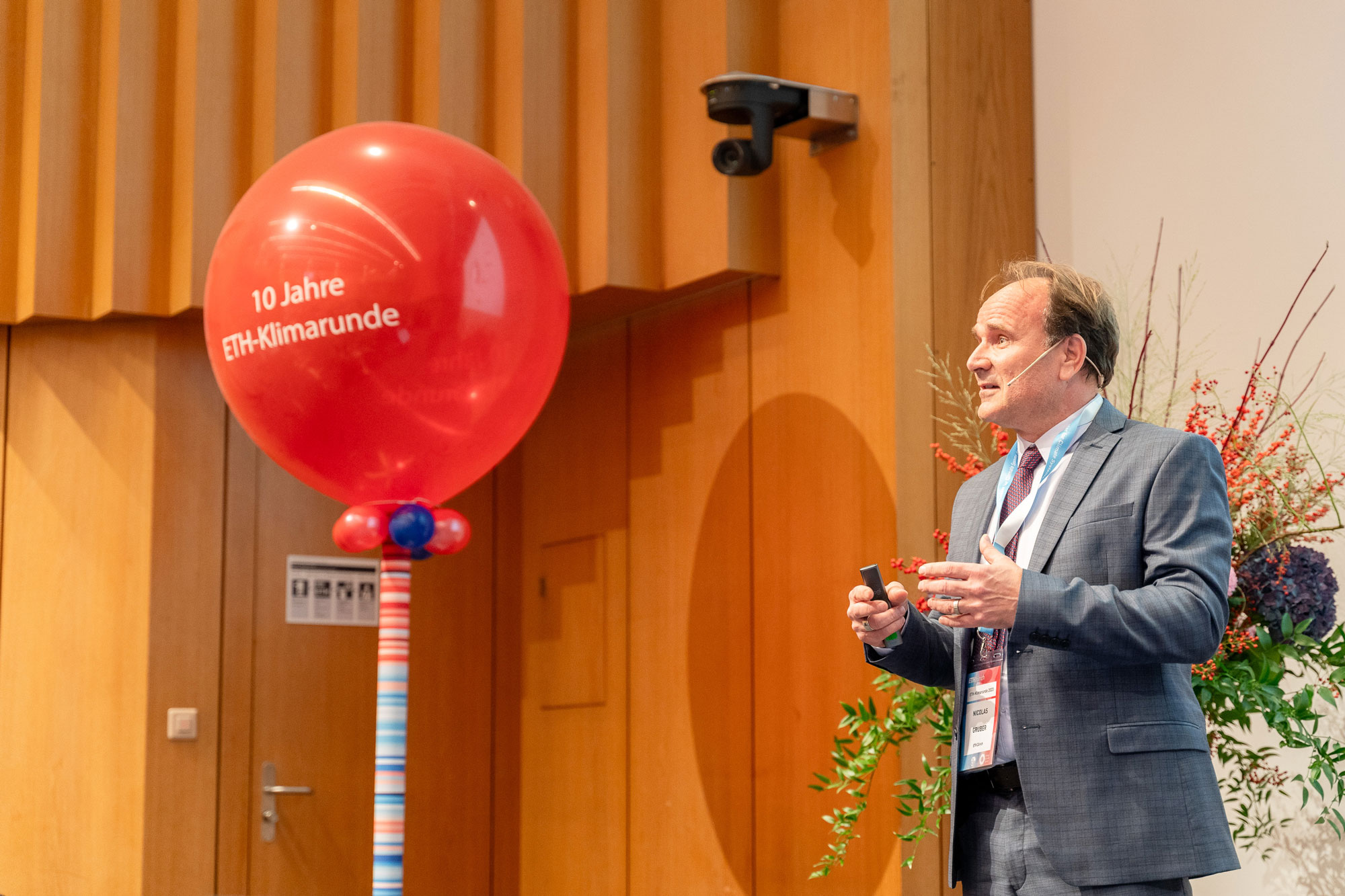
AI/ML Workshop in November 2024
In November 2024, more than 20 C2SM members and community members met for a workshop on discussing potential services of C2SM in the area of artificial intelligence / machine learning (AI/ML). Summarising, there is great interest by the community in these kind of services and already many ideas exist around services of data and software, host of an ML model, as well as training courses. While C2SM could easily be doubled or tripled in size with additionally offering services in AI/ML, unfortunately these ideas cannot be fully implemented at the current level of funding. In preparation for the upcoming self-evaluation of C2SM with ETH’s research commission in autumn 2025, a small group will further develop the topic so that it can be included in its strategic plan for the next five years.
Changes in the C2SM Core Team
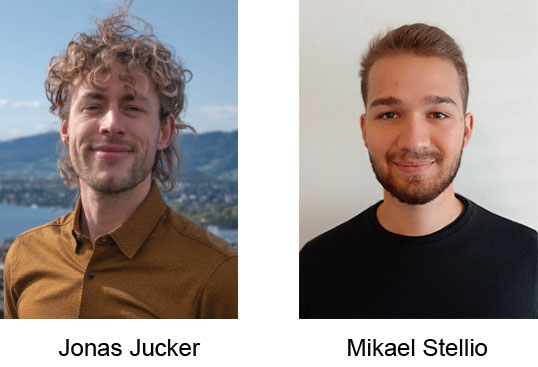
After five years at C2SM, Jonas Jucker will leave us by the end of March to explore the next step of his career. We would like to take this opportunity to thank him most sincerely for his exceptional commitment to and for C2SM, especially for his technical expertise, but also for his creative involvement in the core team.
We are delighted to welcome Mikael Stellio to the C2SM Core Team to follow in Jonas’ footsteps as a new scientific programmer of high-performance computing.
Looking back on the C2SM Community Day 2025
On 24 March in the afternoon, the C2SM Community gathered to learn about C2SM’s activities and exchange about ongoing projects on site at ETH Zurich or online via Zoom.
C2SM executive director Christina Schnadt Poberaj informed about the current organisation of the center and took the opportunity to welcome Sünje Dallmeier-Tiessen from MeteoSwiss, who had been elected as a new member of C2SM at C2SM’s Plenary Assembly in the morning of the same day!
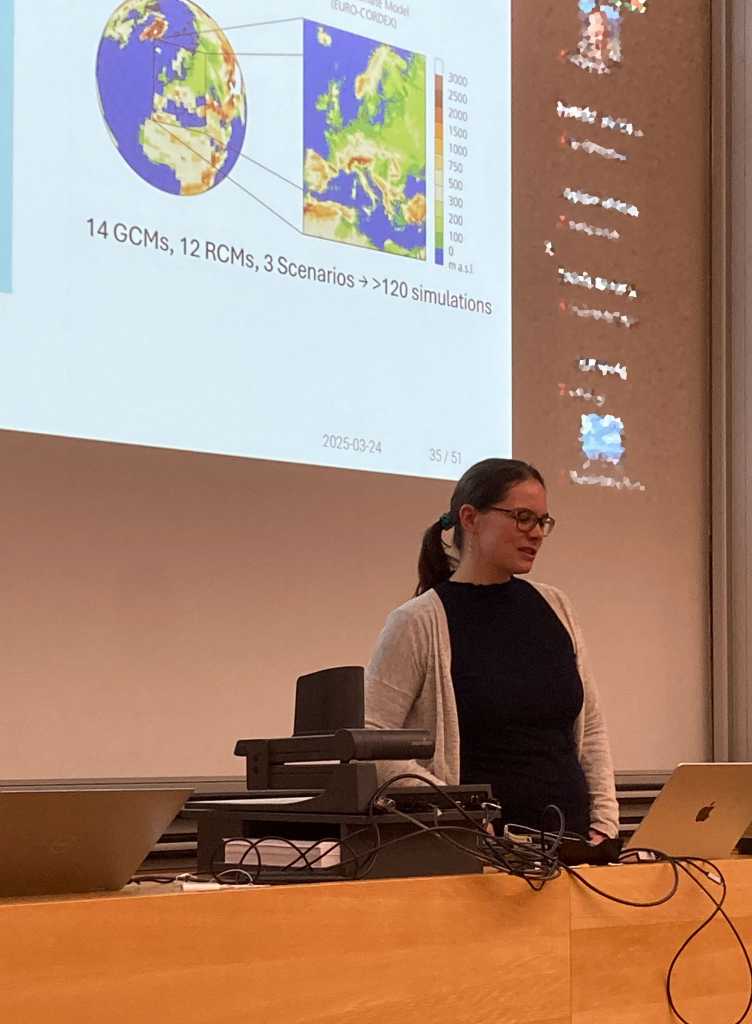
The core team then presented the highlights of their services that they provided during the last two years. In addition, four members from the C2SM community presented updates about their current projects. The coffee break was used for many direct exchanges and networking among the participants, all of this making the Community Day an important component for the successful functioning of the center!
The scientific programmers of the C2SM Executive Office, also well-known as C2SM Core Team, receive the majority of their programming tasks from the four working groups of C2SM, which cover the topics of model development, high performance computing, climate scenarios, and climate impacts. Highlights of successfully completed tasks of the past months are described below.
Working Group 1 (WG 1): High Performance Computing
GPU ports for missing namelist switches for ICON-CLM setup
To support regional climate simulations, the external page Climate Limited-area Modelling (CLM) community has published a recommended setup for ICON. However, this setup included several namelist switches that had not yet been ported to GPUs:
1. Transient ozone climatology
2. Transient solar irradiation
3. MODIS climatology for cloud-droplet number concentration
4. Diagnostic planetary boundary layer height output
These missing components have now been successfully ported to GPUs. C2SM handled the implementation of parts 1–3, while Deutscher Wetterdienst (DWD) was responsible for part 4. As a result, the ICON model can now be efficiently applied to regional climate simulations on the Alps supercomputing system at CSCS, fully leveraging GPU acceleration.
Support ICON cloud tuning parameters on GPU
Another GPU port for ICON has been completed, enabling new cloud tuning parameter settings. These namelist switches, introduced by DWD, aim to improve cloud cover representation in ICON, particularly for stratocumulus clouds. As this port was already merged in June 2024, it is part of the latest open-source ICON release from October (2024.10).
In addition and as part of this task, these changes have been tested in the EXCLAIM version of ICON to ensure compatibility with the domain-specific language (DSL) dynamical core.
Working Group 2 (WG 2): Development of Weather and Climate Models
Store input test data for ICON automated testing on a web accessible server
One of the challenges of testing ICON on a specific infrastructure was that the input data required to run the tests was scattered across multiple locations. Collecting the necessary data for running ICON on a new system was always an effort-intensive task.
This task aimed at improving the situation by harmonising experiment definitions and centralising the input data. The data was placed under version control and is now stored in a special Git repository for large files (Git LFS) at DKRZ. This significantly enhances the portability of ICON to new systems and has already proven highly beneficial during the transition to the new ALPS infrastructure at CSCS.
Porting CESM 2 to Euler Cluster (Ubuntu) with mixed-resolution support
CESM 2 (Community Earth System Model) has been successfully ported to the Euler Cluster running Ubuntu. This includes support for a mixed-resolution, uncoupled setup and run scripts for CESM 2.2.2, the latest development release. Additionally, CESM 2.1.5, the latest stable release, is supported natively on Ubuntu, while CESM 2.1.2 runs inside a container.
Working Group 3 (WG 3): Climate Scenarios
Klima CH2025
The first draft of the scientific report for Klima CH2025 was written by a large team of authors during autumn and winter of 2024/2025. C2SM contributed as co-authors and also helped with technical aspects of the writing process. See also more detailed contribution below .
ICON-CLM in EURO-CORDEX Setup
As part of the EXCLAIM project, one use case focuses on conducting regional climate simulations over Europe using the GPU version of ICON-CLM. These simulations are performed on the EURO-CORDEX domain at a spatial resolution of 12 km.
With the GPU ports for the missing namelist switches in the ICON-CLM setup now completed (see Working Group 1), the next official ICON release of April 2025 will be capable of running such simulations. However, since the official version for CLM simulations is the July 2024 release (2024.07), a patch has been created to integrate the latest developments relevant to this setup.
Before production runs can begin, the Starter Package for ICON-CLM Experiments (SPICE) needed to be adapted and tested for the new Alps system. SPICE ensures that all CLM community groups use consistent settings across different machines and infrastructures, guaranteeing comparability within the EURO-CORDEX balanced matrix to which C2SM will contribute by running one future climate scenario simulation.
Working Group 4 (WG 4): Climate Impacts
Adjustment to updates in the Climate Data Store
Data Management is an important topic for WG4 and the C2SM core team is constantly working on keeping datasets up-to-date and extending available variables for core datasets such as ERA5, ERA5-land or CERRA. Many of these datasets are at least partially downloaded from the Climate Data Store (external page CDS). Since the CDS underwent a major change within the last year we also had to update our scripts to be able to use the new API. In addition we are improving their maintainability.
Past C2SM Courses
Climate model and climate data workshop
The second edition of the “Climate model and climate data workshop” was carried out at ETH in November 2024. This workshop is tailored for the impacts community to gain an overview about what a climate model is, how it works and what it can and cannot provide. Michael Jähn and Ruth Lorenz from the C2SM core team gave the introductory overview. Various technical aspects were discussed including input parameters, the types of output generated, and other important considerations such as uncertainties, biases, and model independence. Jan Rajczak from MeteoSwiss discussed bias-correction methods, as well as advantages and disadvantages of such approaches. In addition, Paul Astagneau from SLF/ETH, an impacts researcher, showed how he uses climate data in his research. The theoretical morning was followed by a practical afternoon with a brief hands-on session on how to use climate data. The most common data format NetCDF was explained, as well as how to read this data into Python and R.
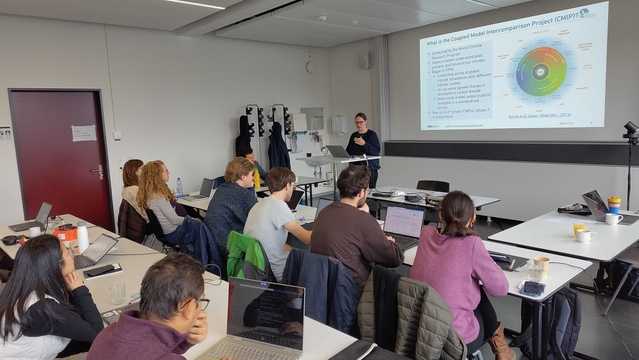

The EXCLAIM project (Extreme Scale Computing and Data Platform for Cloud-Resolving Weather and Climate Modeling) is focused on developing an ICON-model-based infrastructure capable of running kilometre-scale climate simulations at both regional and global scales.
Over the past few months, there has been a critical shift in mindset within the development team. The focus has transitioned from pure development to operational readiness, with the goal of delivering a production-ready ICON-Blue (ICON Fortran with DSL dynamical core) by mid-2025.
By executing the EXCLAIM science roadmap, the early users of ICON-Blue (M. Bukenberger, P. Pothapakula, C. Kroll) have played an essential role in shaping the climate and weather platform designed for kilometre-scale global simulations. This platform is being developed in joint effort by CSCS, C2SM and EXCLAIM. Collaboration with CSCS has strengthened significantly, leading to joint debugging sessions between early users and software/system engineers. This has given a tremendous boost in stabilizing the platform, making it much more robust than it was last year.
Exciting developments are already underway:
- Mona Bukenberger has been investigating jet streaks in global R2B10 (2.5 km horizontal grid spacing) aquaplanet simulations.
- Praveen Pothapakula has been exploring global monsoon systems using a 10-year-long R2B8 simulation with ICON-Blue and is planning to initiate R2B10 simulations soon.
- Clarissa Kroll has been working on global R2B9 uncoupled simulations.
With these advancements, the EXCLAIM platform is rapidly evolving into a powerful tool for high-resolution climate and weather research.
Climate CH2025
The Climate CH2025 project moves into its third and final year this January, with the launch date fixed for 4 November 2025 (see below). In the meantime, the first quarter of 2025 is being used to refine and finalise the Scientific Report, which is currently in its final drafting stages and already being internally reviewed. In March 2025, the report will additionally undergo an external review. The June Steering Group meeting will act as a Milestone for completion of all scientific input to the Project.
In parallel, the communication and design phase of the Project builds momentum throughout the year planning a suite of outputs in time for the official launch. Both teams from MeteoSwiss and ETH Zurich are working hard to achieve these key milestones throughout 2025 - we look forward to receiving feedback on the report itself and implementing the key messages for CH2025 into project products, for both stakeholders and media.
Next Generation Modelling of Terrestrial Carbon Cycle by assimilation of in-situ campaigns and Earth Observations (NextGenCarbon) funded
The ability to evaluate European climate and sustainability targets is currently limited by challenges in monitoring ecosystem greenhouse gas (GHG) exchanges and other services in an accurate and timely manner. The absence of coherent approaches to collect, interpret, and integrate data on terrestrial GHG stocks and processes into predictive models limits Europe’s ability to monitor ecosystem services and thus to reach its climate ambitions, including the Paris Agreement of Climate Convention and European Green Deal. The Horizon Europe funded project Next Generation Modelling of Terrestrial Carbon Cycle by assimilation of in-situ campaigns and Earth Observations (NextGenCarbon) aims to develop a novel framework for advancing the understanding of the European GHG budget. The project consortium consists of 22 partners from eleven countries, among them Nina Buchmann. Her group will focus on in situ observations of agricultural ecosystems using flux measurements and stable isotope analyses.
ICOS Switzerland continues
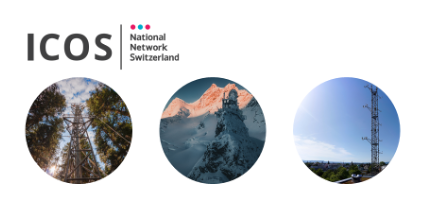
external page ICOS Switzerland (ICOS-CH) received funding for the next project phase (Phase 4, 2025-2029). ICOS-CH is part of the Integrated Carbon Observation System Research Infrastructure (external page ICOS RI), which produces standardised, high-precision and long-term greenhouse gas data throughout Europe, from over 170 measurement stations across 16 countries. ICOS data are openly available at the external page ICOS Carbon Portal. ICOS-CH contributes to ICOS RI with external page three measurements stations which are unique in terms of station history, location and integration into national and international research programs: one Atmosphere station (Jungfraujoch) and two Ecosystem stations (Davos, Basel). All three stations have been continuously measuring greenhouse gases for more than 20 years. With the three stations and the exceptional geographical location in the central part of the Alps, ICOS-CH is an outstanding node within the ICOS RI network since its beginning in 2008.
Towards a more efficient representation of forest demography in Earth System Models using physics-informed diffusion models
Accurate representation of vegetation dynamics in Earth System Models (ESMs) is crucial for understanding land–atmosphere interactions and predicting ecosystem responses under changing climate conditions. However, ESMs often lack sufficiently detailed vegetation components, while stand-alone forest gap models—which simulate establishment, growth, and mortality of individual trees or cohorts—remain computationally expensive, especially when their direct spatial upscaling is attempted. This restricts the direct coupling of forest gap models with ESMs, as ESMs are already resource-intensive.
Recent advances in machine learning, particularly in generative models, present new opportunities to solve these computational challenges. In a new study, Francesco Giardina, Pierre Gentine, Samuel Zweifel and C2SM member Harald Bugmann propose the use of physics-informed diffusion models to emulate a classic forest gap model at a lower computational cost. By incorporating physical constraints and ecological principles within the diffusion process, their approach preserves the key dynamics of forest gap models while improving computational efficiency.
They will present preliminary results demonstrating the flexibility of this framework to incorporate a range of biophysical and biogeochemical processes. The researchers anticipate that this work may contribute to a more robust integration of vegetation dynamics at large scales, allowing for broader, more detailed simulations without prohibitive computational overhead. Although still in its early stages, this approach shows promise for improving climate projections, carbon cycle assessments, and biodiversity conservation.
These activities are part of the European wide external page “Wildcard” project.
New PASC Project "Establishing the Portable Model for Multi-Scale Atmospheric Prediction
This software development project, with co-PIs and C2SM member Heini Wernli (ETH) and Christian Kühnlein (ECMWF), plays a key role in establishing the Portable Model for Multi-Scale Atmospheric Prediction (PMAP), an advancement of the FVM model from ECMWF. PMAP offers several technological and methodological enhancements over existing models and is developed to serve, on the one hand, as a model basis for the operational prediction system at ECMWF and its member state partners and, on the other hand, as a highly flexible and productive simulation tool to be made available to the research community and specifically for atmospheric dynamics research projects at ETH Zurich.
New projects to better understand the sources and sinks of atmospheric methane: ESA project SMART-CH4 and EU project IM4CA
The European Space Agency ESA and the European Commission have funded two new projects dedicated to better understanding the sources and fate of atmospheric methane (CH4), the second most important long-lived greenhouse gas after CO2. The two projects complement each other, with the ESA project focusing on satellite remote sensing and the EU project on new and existing ground-based and airborne observations. In both projects, CH4 observations are integrated with atmospheric transport and inverse modelling to detect and quantify sources.
The ESA project Satellite Monitoring of Atmospheric Methane (SMART-CH4, 2024-2026) aims to further advance CH4 satellite retrievals and to improve our understanding of methane sources and sinks from the scale of individual point sources to the global scale leveraging the growing number of satellites measuring CH4. The project specifically focuses on diffuse sources such as landfills, wetlands and agriculture, which are more difficult to observe from satellites than strong point sources in the oil- and gas-sector, which have been studied in previous projects. The EU project Investigating Methane for Climate Action (IM4CA, 2025-2028) unites leading European methane experts in a concerted effort to establish the scientific fundament needed to bring the climate forcing of methane under control. The project aims to strengthen methane mitigation policy world-wide with actionable information on local methane emissions and key driving processes. It will establish new CH4 observations in under-sampled regions including the Arctic, Africa and eastern Europe.
Empa is involved in both projects, contributing with ICON-ART inverse modelling from the regional to the European scale and with airborne remote sensing with the new imaging spectrometer AVIRIS-4. It will assimilate both satellite and ground-based CH4 observations to quantify the CH4 emissions from poorly known sources such as leakages from oil- and gas-production and from landfills, for example in Romania.
Quantifying past, present, and future Stratospheric and Tropospheric Ozone over the Alps and Europe (STOA)
A new Swiss-Austrian external page SNF project , partnering C2SM community member Timofei Sukhodolov from PMOD/WRC, has started in February 2025. It will will include a combination of global (SOCOL) and regional (WRF-Chem) modelling to study ozone trends. Through the implementation of the Montreal Protocol and its amendments, a decrease in the atmospheric abundance of the controlled ozone-depleting substances was achieved, which has led to increases in the upper-stratospheric ozone. However, no significant trend in total column ozone has been detected in middle latitudes so far. The total column ozone recovery since the 1990’s, especially at northern mid-latitudes is expected to be complex, with a timeline depending on many factors. Ground-based measurements of ozone from well-maintained ground stations are considered as benchmark datasets to validate models as well as the ozone retrieved from satellites. The project aims to quantify trends in total column ozone and in atmospheric ozone layers ranging from the troposphere to the upper stratosphere since the 1990’s. The researchers will be using a comprehensive dataset of ozone measurements from different ozone measuring platforms, including the World’s longest continuous total column ozone dataset from Arosa/Davos.
25th Swiss Global Change Day
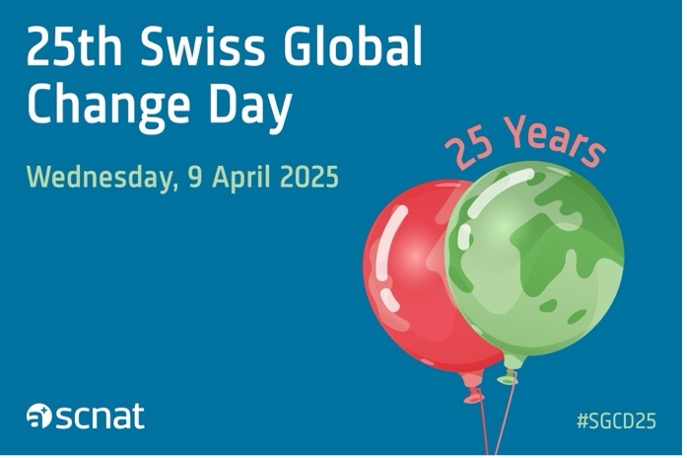
Wednesday, 9 April 2025, Freies Gymnasium Bern
The Swiss Global Change Day is organised every year by ProClim. This year's anniversary edition promises to be another insightful event with top-class keynotes and a panel discussion with C2SM Deputy Chair Sonia Seneviratne, among others.
PhD students and post-docs are invited to present their work at the poster session. Posters can be submitted in the three categories: Geosphere/Biosphere; Atmosphere/Hydrosphere; and Human Dimensions/Sustainability. The best posters in each category will be awarded a travel voucher of 1000 Swiss Francs.
The full program and registration details are available on the external page ProClim website.
EXCLAIM Symposium «Is AI the Future of Weather and Climate Modeling?»
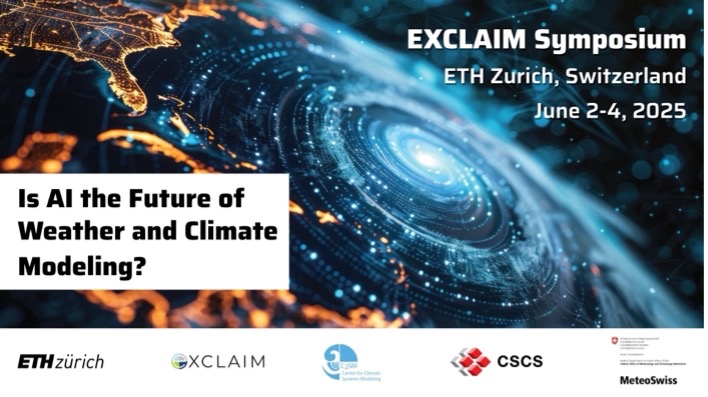
Monday to Wednesday, 2-4 June 2025, ETH Zurich
The EXCLAIM symposium explores the transformative potential of AI-driven and physics-based models in advancing weather and climate prediction. Please join us for an exciting three-day symposium of speakers from academia and industry at the forefront of the field. Through in-depth discussions and analysis, we will examine the latest breakthroughs in numerical and AI-based modeling techniques, highlighting key trends, challenges, synergies and opportunities that are shaping the future of this field.
On Wednesday, June 4, Prof. und President Emeritus Martin Vetterli will give a public keynote on «AI for Science, AI for Society: Two sides of the same coin?», which is open to the general audience.
Please find the full programme and registration details on the EXCLAIM Symposium website.
SAVE THE DATE: 2nd Climate Forum Switzerland
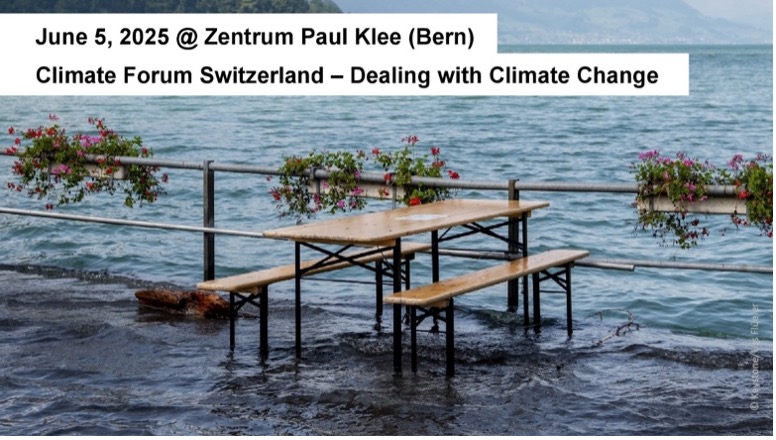
Thursday, 5 June 2025, Zentrum Paul Klee (Bern)
The 2nd Climate Forum Switzerland is themed around “Identifying and reducing climate risks”. The event will focus on the new Swiss climate risk analysis: What are the most important climate risks for Switzerland? How have they developed? And above all, how can we as society address them? These are the questions that the Climate Forum Switzerland 2025 will address.
The event fosters exchange and networking between research, administration and practice. The Climate Forum Switzerland is organised under the umbrella of the National Centre for Climate Services NCCS by the Federal Office for the Environment FOEN and the Federal Office of Meteorology and Climatology MeteoSwiss, with the participation of ProClim – Forum for Climate and Global Change.
The program and registration details will follow soon at external page www.nccs.admin.ch.
Save the date: Launch of the Climate CH2025 results
Tuesday, 4 November 2025, ETH Zurich
With the end of the project period approaching (see above), the key findings of the Climate CH2025 project will be presented at its launch event on Tuesday, 4 November 2025. More information on the event will be available made available at the external page Climate CH2025 website.

We congratulate our community members for their successfully completed PhDs!
- Francesco Zanetta: Improving the usefulness of weather models output with machine learning. ETH Zürich, 11 Sep 2024.
- Nicolai Krieger: Large-eddy simulations with PMAP and applications to a local Alpine windstorm. ETH Zürich, 04 Dec 2024.
- Michael Steiner: Towards improved accuracy in greenhouse gas inversions: Addressing transport uncertainties in ensemble-based methane inversions with ICON-ART, ETH Zurich, 20 Sep 2024
- Nadja Omanovic: From local observations to large-eddy simulations: refining cloud microphysical processes in a weather forecast model, ETH Zurich, 17 Dec 2024

- external page Können wir mit «künstlichen Wolken» die Klimaerwärmung bremsen? Und wenn ja, wäre das klug?
Prof. Ulrike Lohmann, Republik, 24.01.2024 - external page Segeln und forschen, wo sonst niemand hinkommt
Prof. Nicolas Gruber, NZZ, 04.01.2025 - external page Bundesrat will CO₂ für 30 Jahre speichern – Wissenschaft empfiehlt 1000
Dr. Cyril Brunner, Tagesanzeiger, 19.12.2024
Drastic increase in the magnitude of very rare summer-mean vapor pressure deficit extremes
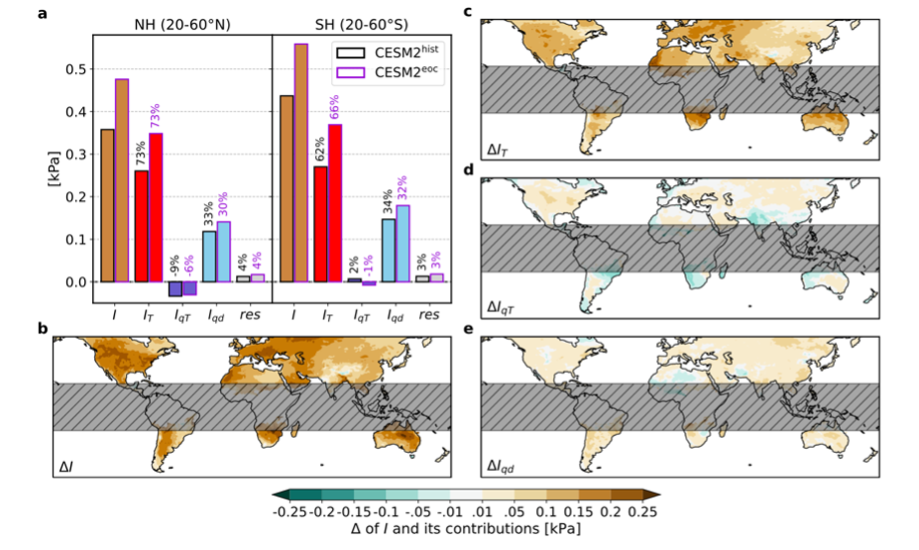
Summers with extremely high vapor pressure deficit (VPD) contribute to crop losses, ecosystem damages, and wildfires. This study identifies very rare summer VPD extremes globally in reanalysis data and CESM2 climate model simulations, and quantifies the contributions of temperature (T) and humidity (q) anomalies to their intensity. The methodological novelty of the study is this decomposition of VPD anomalies into contributions from T anomalies, and from q anomalies, where the latter is further split into a contribution that results from the climatological co-variability of q with T, and one that is unrelated to this co-variability. The latter is interpreted by the researchers as contributions from dynamically induced humidity anomalies. The CESM2 simulations agree with reanalysis data regarding these physical characteristics of historic vapor pressure deficit extremes, and show a +33/+28% increase in their intensity in the northern/southern mid-latitudes over this century. About half of this drastic increase in the magnitude of extreme VPD anomalies is due to climate warming, since this quantity depends exponentially on temperature. Further contributing factors are increasing temperature variability (e.g., in Europe) and the expansion of soil moisture-limited regions. The study shows that to avoid amplified impacts of future VPD extremes, ecosystems and crops must become more resilient not only to an increasing mean VPD, but additionally also to larger seasonal anomalies of this quantity relative to the evolving climatological mean.
Hermann, M., H. Wernli, and M. Röthlisberger (2024): Drastic increase in the magnitude of very rare summer-mean vapor pressure deficit extremes. Nature Communications volume 15, Article number: 7022, external page https://www.nature.com/articles/s41467-024-51305-w
Projections of heavy precipitation characteristics over the greater Alpine region using a kilometer-scale climate model ensemble
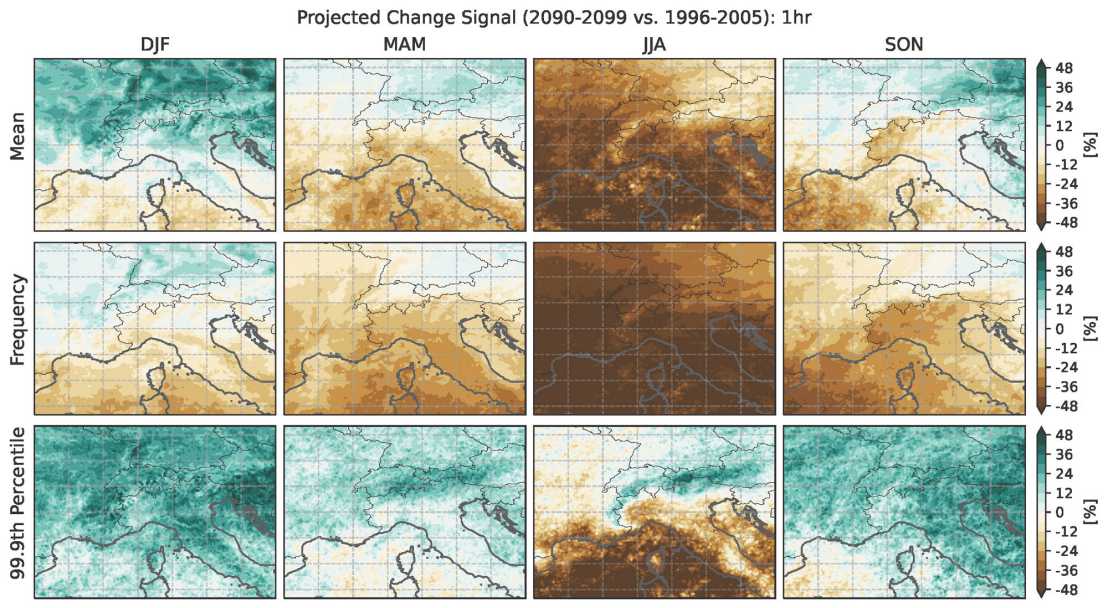
A recently published study employs a first-of-its-kind multi-model ensemble of convection-permitting simulations (CPMs) to analyse projected changes in heavy precipitation characteristics across the Alpine region. The study includes a systematic evaluation against high-resolution daily and hourly observations, as well as a comprehensive comparison of CPMs with regional (RCMs) and global climate models (GCMs).
The findings indicate that CPMs offer significant improvements, refining spatial patterns, reducing the overestimation of precipitation frequency, and better capturing heavy precipitation, particularly on sub-daily scales and during summer.
Projections show fundamental changes in the Alpine precipitation climate, with reduced summer precipitation and increased winter precipitation. Heavy precipitation is projected to intensify across all seasons and temporal aggregations, with the strongest signals for short-duration rainfall events.
Despite variations in large-scale circulation changes among driving GCMs, CPM projections remain consistent, indicating that the intensification of heavy precipitation is primarily driven by thermodynamic effects.
Estermann, R., J. Rajczak, P. Velasquez, R. Lorenz, and C. Schär (2025). Projections of heavy precipitation characteristics over the Greater Alpine Region using a kilometer–scale climate model ensemble. Journal of Geophysical Research: Atmospheres, 130, e2024JD040901. external page https://doi.org/10.1029/2024JD040901
European CH4 inversions with ICON-ART coupled to CarbonTracker Data Assimilation Shell
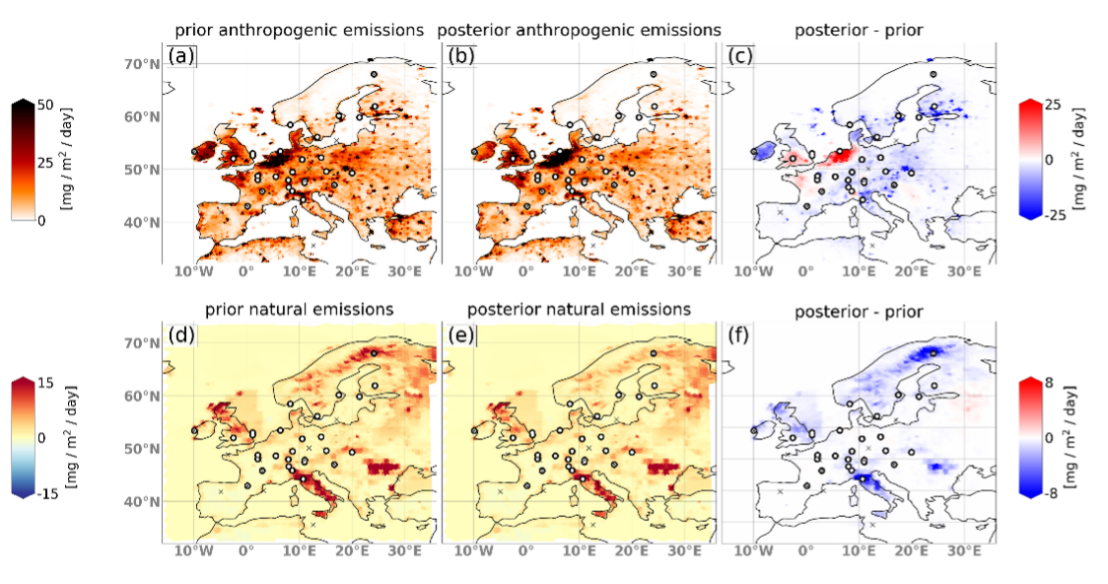
Methane (CH₄) is a potent greenhouse gas with a relatively short atmospheric lifetime, making it a prime target for near-term climate mitigation strategies. Independent monitoring of these emissions on a country-scale is crucial to verify the emissions reported to the United Nations Framework Convention on Climate Change and reduction targets.
Atmospheric inverse modeling offers a tool to estimate emissions top-down based on atmospheric observations. Despite the evident promise of this method, it remains subject to considerable uncertainties, which are usually dominated by errors in the simulation of atmospheric transport. To improve the reliability of these inversions, it is therefore essential to reduce transport errors and use state-of-the-art models such as ICON-ART.
In their study, Steiner et al. present the first application of ICON-ART in inverse modeling of CH₄ fluxes using an ensemble Kalman smoother. The study optimized European CH₄ emissions on a national scale, employing in-situ measurements from 28 European stations for the years 2008, 2013, and 2018. Their results suggest that anthropogenic CH₄ emissions in the Benelux countries may be underestimated in the EDGARv6 inventory by about 25%, while emissions in many other parts of Europe were adjusted slightly downward. The posterior total emissions over Europe (EU27 + UK) for the year 2018 were estimated to 17.4 Tg CH₄ compared to 19.9 Tg CH₄ in the EDGARv6 inventory. This value closely aligns with the 17.8 Tg CH₄ per year reported by the countries to the UNFCCC.
Steiner, M., W. Peters, I. Luijkx, S. Henne, H. Chen, S. Hammer, and D. Brunner (2024): European CH4 inversions with ICON-ART coupled to the CarbonTracker Data Assimilation Shell, Atmos. Chem. Phys., 24, 2759–2782, external page https://doi.org/10.5194/acp-24-2759-2024.
More papers from the C2SM community:
For publications with more than ten authors we cite the first author together with the author(s) from the C2SM community.
- Astigarraga J., L. A. König, et al. (2024): Relative decline in density of Northern Hemisphere tree species in warm and arid regions of their climate niches. Proceedings of the National Academy of Sciences of the United States of America 121.28: e2314899121.
- Bose A.K., A. Gessler, U. Büntgen, and A. Rigling (2024): Tamm review: Drought-induced Scots pine mortality – trends, contributing factors, and mechanisms. Forest Ecology and Management 561: 121873.
- Deutsch L., A. Björnsen A., A.M. Fischer, A. M. Hama, N.E. Zimmermann, C. Zurbrügg C., and S. Hoffmann (2024): Herding cats: integrative leadership strategies in inter- and transdisciplinary research programs, Sustainability Science, external page https://doi.org/10.1007/s11625-024-01585-4
- Fons E., A. K. Naumann, D. Neubauer, T. Lang, and U. Lohmann (2024) Investigating the sign of stratocumulus adjustments to aerosols in the ICON global storm-resolving model, Atmos. Chem. Phys., 24, 8653–8675, doi.org/10.5194/acp-24-8653-2024
- Goger, B. and A. Dipankar (2024): The impact of mesh size, turbulence parameterization, and land-surface-exchange scheme on simulations of the mountain boundary layer in the hectometric range, In: Quarterly Journal of the Royal Meteorological Society 150/763, pp. 3853-3873 external page https://doi.org/10.1002/qj.4799
- Golding N., K. Lambkin, L. Wilson, R. De Troch., A.M. Fischer, H.O. Hygen, A.M. Hama A.M., A. Verpe Dyrrdal, E. Jamsin, P. Termonia, and C. Hewitt (2024). Developing national frameworks for climate services: Experiences, challenges and learnings from across Europe. Climate Services, 37, 100530. external page https://doi.org/10.1016/j.cliser.2024.100530
- Krebs L., S. Burri, I. Feigenwinter, M. Gharun, P. Meier, and N. Buchmann (2024) Forest-floor respiration, N2O and CH4 fluxes in a subalpine spruce forest: Drivers and annual budgets. Biogeosciences 21: 2005–2028, external page https://doi.org/10.5194/bg-21-2005-2024
- Nelson J.A., N. Buchmann, L. Hörtnagl, I.Feigenwinter, F. Turco, Y. Wang, M. Jung, et. al. (2024): X-BASE: the first terrestrial carbon and water flux products from an extended data-driven scaling framework, FLUXCOM-X. Biogeosciences 21: 5079–5115, external page https://doi.org/10.5194/bg-21-5079-2024
- Omanovic, N., B. Goger, and U. Lohmann (2024): The impact of the mesh size and microphysics scheme on the representation of mid-level clouds in the ICON model in hilly and complex terrain, In: Atmospheric Chemistry and Physics 24/24, pp. 14145–14175 external page https://doi.org/10.5194/acp-24-14145-2024
- Scherrer D., R. Lüthi, H. Bugmann, J. Burnand, T. Wohlgemuth, and A. Rudow (2024): Impacts of climate warming, pollution, and management on the vegetation composition of Central European beech forests. Ecological Indicators 160: 111888.
- Shekhar A., N. Buchmann, V. Humphrey, and M. Gharun (2024) More than three-fold increase in compound soil and air dryness across Europe by the end of 21st century. Weather and Climate Extremes 44: 100666, external page https://doi.org/10.1016/j.wace.2024.100666
- Stefanetti, F., S. Vattioni, J.A. Dykema, G. Chiodo, J. Sedlacek, F.N. Keutsch, and T. Sukhodolov (2024) : Stratospheric injection of solid particles reduces side effects on circulation and climate compared to SO2 injections, Environ. Res.: Climate 3 045028, external page https://doi.org/10.1088/2752-5295/ad9f93
- Vattioni, S., R. Weber, A. Feinberg., A. Stenke, J.A. Dykema, B. Luo, G.A. Kelesidis, C.A. Bruun, T. Sukhodolov, F.N. Keutsch, T. Peter, and G. Chiodo (2024): A fully coupled solid-particle microphysics scheme for stratospheric aerosol injections within the aerosol–chemistry–climate model SOCOL-AERv2, Geosci. Model Dev., 17, 7767–7793, external page https://doi.org/10.5194/gmd-17-7767-2024
